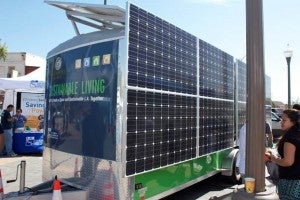Transforming an Energy Burden into an Energy Opportunity
 Economic inequality has become one of the dominant political narratives of the day. It occupies discussions on both sides of the aisle, and is shaping elections from city halls to the White House. There’s a good reason for this: the continuing trends of flattening incomes, concentrated wealth, and deepening poverty are historic.
Economic inequality has become one of the dominant political narratives of the day. It occupies discussions on both sides of the aisle, and is shaping elections from city halls to the White House. There’s a good reason for this: the continuing trends of flattening incomes, concentrated wealth, and deepening poverty are historic.
One place this reality is really hitting home for millions of Americans is on their monthly energy bill. For nearly one in three American families, paying a monthly energy bill is a challenge.
The energy burden, as the Department of Energy defines it, is the ratio of energy costs (which includes heating, cooling, appliances, and lighting from electricity, gas, and fuel sources) to household income. Nearly 40 percent of low-income households use electricity to heat their homes (the majority in the South and West), and are suffering a more severe energy burden because of factors like wage stagnation and the quality of housing at lower economic levels. In 2014, researchers looking at the “energy affordability gap” for low income households (the difference between actual energy bills and what is considered affordable) tabulated it at almost $45 billion nationally. That is an increase of 16 percent from 2011, with nearly 60 percent of the growth accounted for by states in the mid-South, South, and east of the Mississippi. For any of those families, even a 10 percent growth in electricity costs can be destabilizing. Monthly electric bills become another factor forcing households to choose between groceries, childcare, and medical bills.
To make inroads in closing the energy affordability gap and reducing energy burdens for the most vulnerable, Environmental Defense Fund believes we need a combination of greater and scalable clean energy investment in low- and moderate-income communities, and a focus on empowering the many faces that are energy-burdened. The multi-billion dollar affordability gap certainly poses a variety of financial risks, but it’s also rife with opportunity.
It still takes a village: Start with partnerships at home and scale from there
Sparking investment, innovation, and access to clean energy solutions in low- and moderate-income markets requires sustained engagement and strong enabling policy rooted in cross-sectoral partnerships. For example, in Los Angeles we are partnering with local labor, economic justice, and environmental justice organizations to educate communities about what renewable power can do for quality of life and community health. These partnerships, as my colleague Jorge Madrid has pointed out, can nurture place-based investments like shared solar and other distributed energy programs that use the power of collective purchasing, pay-as-you go subscriptions, and other innovative models to create access to clean power. They show in tangible ways the job-creating and social benefits of clean energy. Moreover, if these clean energy demonstrations are coupled with the guiding principles laid out in the just released “Low-Income Solar Policy Guide,” – which outlines a variety of tested, local interventions ranging from financing tools, direct incentives, and technical assistance, to net metering compensation bill credits that can make clean energy affordable – they can address the question of financial risk and be scaled to transformative levels.
[Tweet “Transforming an Energy Burden into an Energy Opportunity”]
Empowering customers translates into encouraging various efficiency, payment, data-access, and awareness strategies that help people simply use less. To get there, we must also recognize that there is a learning curve for many people in understanding the advantages offered by the smart grid. It also means encouraging innovative, partnership-based energy efficiency and other energy-use reduction programs – as my colleague Marilynn Marsh-Robinson has written about – that are within reach and accessible for all. A new report from the American Council for an Energy-Efficient Economy (ACEEE) suggests that low-income households pay nearly 25 percent more on energy per square foot compared to the general population because they often use older appliances, electric space and water heaters, and don’t have programmable thermostats. Pairing energy efficiency with on-bill solutions (which allow people to repay clean energy loans through their utility bills) ensures renters and homeowners can get upgrades without traditionally high upfront costs.
Essential, federal energy-assistance programs like LIHEAP and WAP are also helping to close the energy affordability gap. Combined, they accounted for approximately $4 billion in fiscal year 2015. These programs prioritize bill assistance and efficiency for the most vulnerable, but have also witnessed an increased demand in recent years. Various state and utility-efficiency and bill-assistance programs, as well as the U.S. Department of Agriculture’s Rural Utility Service, also help fill the need. And some utilities are certainly recognizing just how vast and heterogeneous their at-risk customer base is. Yet, while there are a variety of federal, state, and local efforts aimed at closing the affordability gap, more needs to be done.
How to ensure real, lasting change
Clean energy is a potent tool in fighting inequality and making sure all families are able to participate in the clean energy future. These are families that live in towering high-rises in the Northeast, the shotgun houses of the Southeast, the colonias of the Rio Grande Valley in Texas, and the manufactured homes of California’s Central Valley.
Just like the grid that delivers electricity, making clean energy accessible for everyone facilitates high-impact, multi-dimensional partnerships that transmit power across the spheres of community development, public health, education, and other sectors where the impacts of economic inequality are reverberating.
Holistic, inclusive solutions are hard, but for energy-burdened communities, they are what is absolutely needed. These cross-sectoral, co-benefit solutions are exactly what leads to real change. It’s also how you can turn a burden into an opportunity.
Photo credit: Chloe Looker











